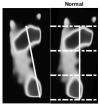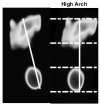Optical-Based Foot Plantar Pressure Measurement System for Potential Application in Human Postural Control Measurement and Person Identification
- PMID: 34203534
- PMCID: PMC8271937
- DOI: 10.3390/s21134437
Optical-Based Foot Plantar Pressure Measurement System for Potential Application in Human Postural Control Measurement and Person Identification
Abstract
Plantar pressure, the pressure exerted between the sole and the supporting surface, has great potentialities in various research fields, including footwear design, biometrics, gait analysis and the assessment of patients with diabetes. This research designs an optical-based foot plantar pressure measurement system aimed for human postural control and person identification. The proposed system consists of digital cameras installed underneath an acrylic plate covered by glossy white paper and mounted with LED strips along the side of the plate. When the light is emitted from the LED stripes, it deflects the digital cameras due to the pressure exerted between the glossy white paper and the acrylic plate. In this way, the cameras generate color-coded plantar pressure images of the subject standing on the acrylic-top platform. Our proposed system performs personal identification and postural control by extracting static and dynamic features from the generated plantar pressure images. Plantar pressure images were collected from 90 individuals (40 males, 50 females) to develop and evaluate the proposed system. In posture balance evaluation, we propose the use of a posture balance index that contains both magnitude and directional information about human posture balance control. For person identification, the experimental results show that our proposed system can achieve promising results, showing an area under the receiver operating characteristic (ROC) curve of 0.98515 (98.515%), an equal error rate (EER) of 5.8687%, and efficiency of 98.515%.
Keywords: biometrics; foot pressure; gait analysis; human postural balance.
Conflict of interest statement
The authors declare no conflict of interest.
Figures
















References
-
- Guoand Y., Lanmei W. Recent advance in plantar pressure measurement system. Sens. Transducers. 2012;145:96–105.
-
- Racic V., Pavic A., Brownjohn J.M.W. Modern facilities for experimental measurement of dynamic loads induced by humans: A literature review. Shock Vib. 2013;20:53–67. doi: 10.1155/2013/975956. - DOI
-
- Ma R., Hu F. An Intelligent Thermal Sensing System for Automatic, Quantitative Assessment of Motion Training in Lower-Limb Rehabilitation. IEEE Trans. Syst. ManCybern. Syst. 2018;48:661–669. doi: 10.1109/TSMC.2016.2636660. - DOI
MeSH terms
LinkOut - more resources
Full Text Sources
Medical

